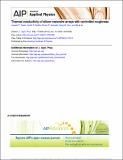Thermal conductivity of silicon nanowire arrays with controlled roughness
Author(s)
Feser, Joseph P.; Sadhu, Jyothi S.; Azeredo, Bruno P.; Hsu, Keng H.; Ma, Jun; Kim, Junhwan; Seong, Myunghoon; Fang, Nicholas Xuanlai; Li, Xiuling; Ferreira, Placid M.; Sinha, Sanjiv; Cahill, David G.; ... Show more Show less
DownloadFang_Thermal conductivity.pdf (753.7Kb)
PUBLISHER_POLICY
Publisher Policy
Article is made available in accordance with the publisher's policy and may be subject to US copyright law. Please refer to the publisher's site for terms of use.
Terms of use
Metadata
Show full item recordAbstract
A two-step metal assisted chemical etching technique is used to systematically vary the sidewall roughness of Si nanowires in vertically aligned arrays. The thermal conductivities of nanowire arrays are studied using time domain thermoreflectance and compared to their high-resolution transmission electron microscopy determined roughness. The thermal conductivity of nanowires with small roughness is close to a theoretical prediction based on an upper limit of the mean-free-paths of phonons given by the nanowire diameter. The thermal conductivity of nanowires with large roughness is found to be significantly below this prediction. Raman spectroscopy reveals that nanowires with large roughness also display significant broadening of the one-phonon peak; the broadening correlates well with the reduction in thermal conductivity. The origin of this broadening is not yet understood, as it is inconsistent with phonon confinement models, but could derive from microstructural changes that affect both the optical phonons observed in Raman scattering and the acoustic phonons that are important for heat conduction.
Date issued
2012-12Department
Massachusetts Institute of Technology. Department of Mechanical EngineeringJournal
Journal of Applied Physics
Publisher
American Institute of Physics (AIP)
Citation
Feser, Joseph P., Jyothi S. Sadhu, Bruno P. Azeredo, et al. Thermal Conductivity of Silicon Nanowire Arrays with Controlled Roughness. Journal of Applied Physics 112(11): 114306, 2012. © 2012 American Institute of Physics
Version: Final published version
ISSN
0021-8979
1089-7550